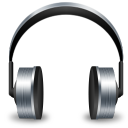Pearl of East: Your travel guide in Uzbekistan.
|
Main Menu
Tashkent
Samarkand
Bukhara
Khiva
Baysun
Nukus
Margilan
Ferghana
Nurata
Namangan
Kokand
Sarmysh Say
Termez
|
News / НовостиUzbekistan: Discover Places of Interest outside the Ichon Qal'a Wall in Khiva05/02/2017 13:10
Khiva is one of the historical cities of Uzbekistan. There are too many architectural monuments and museums in Khiva. Besides the museums in Ichon Qal’a there are also many places of interest in Deshon Qal’a.
Nurullaboy Complex
To build an impressive complex for his son, Prince Isfandiyor Khan, Muhammad Rakhim Khan II bought a huge garden located just outside the Ichon Qal'a wall from the wealthy citizen, Nurullaboy. The Nurullaboy Hovlilari Complex, built between 1884 and 1912, included a harem and is surrounded by high walls. After his father's death, Isfandiyor Khan added a palace for the reception of foreign guests. This palace differs from the other royal residences in Khiva because of its exceptional building style and its extravagant ornamentation. Oriental and European architecture are intermixed. All seven rooms are decorated differently. Colourful Russian-style tiled stoves, huge mirrors, oriental multi-coloured wooden ceilings adorned with geometric or flower patterns, or half-moon and star symbols are combined with angels drawn by Russian artists. The high doors, windows and the parquet floors were made by German Mennonite carpenters who lived nearby, in Oqmasjid village. Next to the palace, there is a small local recreation park where you can enjoy a cup of tea in one of the teahouses. Adjacent to the park, you will see parts of the outer city wall (Deshon Qal'a) of Khiva.
Qibla Toza Bog', the Khan's Summer Residence
In 1897, Muhammad Rakhim Khan II built Qibla Toza Bog' as his summer residence. The palace The palace complex covers an area of 120m x 50m. It consists of the two-storey residence itself, a
library, a harem, stables, a mill and other service buildings grouped around three courtyards. In the middle of the main courtyard, there is a pool shaded by four Field Elm trees. The reception palace, now used as restaurant, was built in 1913 by Isfandiyor Khan. The high windows and doorframes were made by German Mennonite carpenters. The rooms, which are used as a restaurant, are decorated with ornamental wall stucco and have beautifully painted wooden ceilings.
Xusan Muhammadboy Madrassa Xusan Muhammadboy Madrassa is located near the East Gate of Ichon Qal'a (Polvon Darvoza), next to the bazaar. The madrassa was built by the rich merchant, Xusan Muhammadboy in 1905. He was a follower of the Jadid movement, which advocated the reform of the Muslim education system. In 2013, the madrassa was tastefully restored and is now used as a restaurant offering traditional Khorezmian food.
Sayid Mohi Royi Jahon Complex
The tombstones are richly decorated with blue majolica. The graves of other family members of the khan are in adjacent buildings. Islom Hoja, the vizier of the khan, is buried in the building to the right of the main mausoleum.
The Khiva Ice House Several ice houses, Muzxona, were built during Muhammad Amin Khan's reign (1851-1855) inside the walls of Deshon Qal'a, next to water reservoirs. One of them is located south-west outside of
Ichon Qal'a, near the Bol Xauz reservoir. It is a 7 m high dome structure out of burnt bricks, 10 m in diameter with 1.5m thick walls. Its base goes 2 m into the ground. In winter, when the water in the reservoir froze, ice was cut into large blocks and stored in the ice house. Layers of reeds were packed as isolation material between the ice blocks. In the hot season, the ice was used as drinking water.
The To'rt Shovvoz Complex To'rt Shovvoz is a medium-size complex located in easy walking distance from Ichon Qal'a, only 250 In 1642, the complex was developed as a burial ground. According to the legend, Isfandiyor Khan I ordered to build a mausoleum to bury three of his bravest soldiers. Hence, the site was initially called Uch Shovvoz (Three Eagles).
In the course of history the complex was extended and reconstructed several times: in 1843, by Allakuli Khan, in 1874-75 by Muhammad Rakhim Khan II and by the trader Xudoybergan Karvanbashi in 1874.
Khorezm Mamun Academy The Great Silk Road stimulated the development of trade, agriculture, religion, handicrafts as well as sciences. In Gurganch (now Kunya Urgench), the academy, Dorul-hikma was established by the Khorezm Shakh, AN Ibn Mamun and operated from about 1004 till 1017. Research in the fields of astronomy, mathematics, medicine, chemistry, geography, Ten centuries passed, before in November 1997, Presently the academy houses a library with 20,000 historic books and more than 200 copies of manuscripts. Many scientists and researchers from different disciplines work here. The scholars from the academy cooperate with several scientific institutes in the world.
Archaeologists from the academy are carrying out excavation works in historical sites like Khumbuz Tepa - one of the oldest pottery centres in Central Asia. Well-preserved earthenware, dating back to 4th century BC were found there.
The Oriental Bazaars of Khiva If you want to experience the everyday life of people, a visit to one of the colourful oriental bazaars is necessary. The Dehqon Bazaar is located just outside Polvon Darvoza, the East Gate of Ichon Qal'a. Here a great variety of fresh and dried fruit, vegetables and other food items are sold. There are many small teahouses where you can try tasty traditional food. The Mol Bazaar, livestock market, 1km southeast of Polvon Darvoza, is something for early risers. On Sundays, from 6:00 - 9:00 farmers from the region come to deal in livestock, fodder and fuel wood. On the Buyum Bazaar, 800m east of the East Gate of Ichon Qal'a, household items, electric equipment and clothes are sold. Around the corner, on Ehtiyot Qismlari Bazaar, you can find all kinds of new and well used spare parts.
|
Calendar
Weather
Useful Links
Searching for Airways and Hotels
|

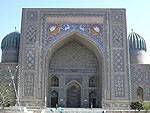
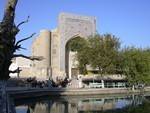
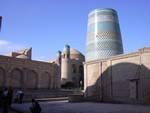
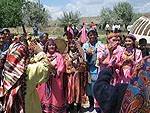
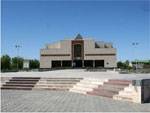
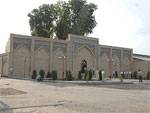
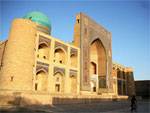
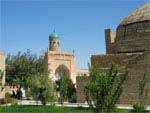
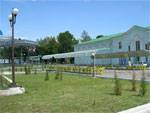


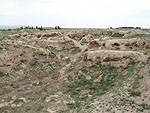
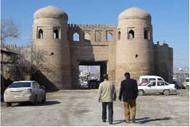
 The Nurullaboy Complex is situated a few hundred meters north of the West Gate of Ichon Qal'a. While the reception palace is open to visitors, the rest of the complex is under renovation. Nurullaboy Madrassa is used as dancing hall for wedding parties.
The Nurullaboy Complex is situated a few hundred meters north of the West Gate of Ichon Qal'a. While the reception palace is open to visitors, the rest of the complex is under renovation. Nurullaboy Madrassa is used as dancing hall for wedding parties.


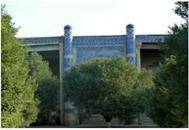



 He made great efforts to introduce European art and culture to Khiva. Muhammadboy actively supported educating the youth of all social groups. Despite of his status and wealth, he fought against feudalism. Because of his beliefs, he was killed by Junaid Khan in 1918.
He made great efforts to introduce European art and culture to Khiva. Muhammadboy actively supported educating the youth of all social groups. Despite of his status and wealth, he fought against feudalism. Because of his beliefs, he was killed by Junaid Khan in 1918. In the 19th century, Muhammad Rakhim Khan II erected the mausoleum for his grandfather Sayid Mohi Royi Jahon, over the tomb of Sheikh Chadirli Ishan. The complex consists of three buildings. The main mausoleum is the burial site of several famous Khiva khans of the Kungrad dynasty, among them Eltuzar Khan, Muhammad Amin Khan, Muhammad Rakhim Khan II, his father, Sayid Muhammad Khan and his grandson, Temurghazi Tura and others.
In the 19th century, Muhammad Rakhim Khan II erected the mausoleum for his grandfather Sayid Mohi Royi Jahon, over the tomb of Sheikh Chadirli Ishan. The complex consists of three buildings. The main mausoleum is the burial site of several famous Khiva khans of the Kungrad dynasty, among them Eltuzar Khan, Muhammad Amin Khan, Muhammad Rakhim Khan II, his father, Sayid Muhammad Khan and his grandson, Temurghazi Tura and others.

 m north-east of the Dehqon Bazaar. It consists of a minaret, winter and summer mosques, three madrassas and two Koran reciting centres, grouped around a water basin shaded by big elm trees and a dome-shaped water reserve.
m north-east of the Dehqon Bazaar. It consists of a minaret, winter and summer mosques, three madrassas and two Koran reciting centres, grouped around a water basin shaded by big elm trees and a dome-shaped water reserve. When Isfandiyor Khan I was buried at the same site, the name changed into To'rt Shovvoz (Four Eagles). In the 17th century, a 12 meter high minaret was added to the site.
When Isfandiyor Khan I was buried at the same site, the name changed into To'rt Shovvoz (Four Eagles). In the 17th century, a 12 meter high minaret was added to the site.
 One of the three madrassas is named after the latter. Recently the To'rt Shovvoz Complex had been under reconstruction, but was opened to the public in 2016.
One of the three madrassas is named after the latter. Recently the To'rt Shovvoz Complex had been under reconstruction, but was opened to the public in 2016. mineralogy, history, philosophy, literature and theology was undertaken there. Together with the Plato Academy in Athens, and the Bayt al-Hikma Academy in Baghdad, the Mamun Academy was one of the most famous scientific institutions in Central Asia. Famous scholars and encyclopedists like Abu Raikhan al-Beruniy, and Ibn Sina (Avicenna) were based here, making important contributions to the development of science.
mineralogy, history, philosophy, literature and theology was undertaken there. Together with the Plato Academy in Athens, and the Bayt al-Hikma Academy in Baghdad, the Mamun Academy was one of the most famous scientific institutions in Central Asia. Famous scholars and encyclopedists like Abu Raikhan al-Beruniy, and Ibn Sina (Avicenna) were based here, making important contributions to the development of science. President Islam Karimov issued a decree to rebuild the Mamun Academy in Khiva. In November 2006, the academy celebrated its 1000th anniversary with the participation of great scientists from all over the world.
President Islam Karimov issued a decree to rebuild the Mamun Academy in Khiva. In November 2006, the academy celebrated its 1000th anniversary with the participation of great scientists from all over the world.
